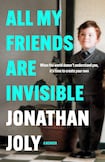
Sitting in Gatwick Airport, about to set off for a holiday to celebrate his 36th birthday, Jonathan Joly has an experience that unnerves him enough to walk away from his wife and children and find a place to hide. Not a conventional panic attack, but a sudden return to the place he had long thought lost to him, the alternative world he knows as “Domdie” that, as a child, he had retreated to in his mind as a means of coping with life’s challenges.
Now, once more in Domdie, in that alternative world, he is told by one of its inhabitants: “It’s time to open the box.” All My Friends Are Invisible is Joly’s account of what that box contained, and how it came to be closed as a teenager before its reappearance in his life decades later.
Joly, for those new to him, is creator, with his wife Anna Saccone, of a popular YouTube series and they have amassed more than seven million followers and fans across various social media platforms. His book is an account of how he learned to survive the tribulations of his childhood, and what it was that he needed to survive.
Beginning aged three, Joly recounts clear recollections of the day he experiences anxiety joining junior school, and how an incident of humiliation incites the first sighting of one of his invisible friends. She will not only introduce him to Domdie, but guard and protect him throughout childhood. This friend is Giselle, who, the infant Joly is aware, “isn’t even ‘real’, as nobody else can see her”.
The question of what is and what is not real, and how important that distinction is to one who needs a different reality to survive, hovers over the book.
While social anxiety initially seems the main trigger for the appearance of the invisible friends and the need to disappear to Domdie for good, Joly also has to contend with an increasingly volatile father and a frequently distant, unaffectionate mother. Meanwhile, his other world is firmly established by the time his young life takes a darker turn when he is introduced to the harsher world of an all-boys school.
There a teacher bluntly addresses the incoming boys with the instruction: “you need to man up … we don’t have time to be girls here”. The young Joly, who enjoys dressing in his sister’s clothes and feels more emotionally connected to girls, is thrust into a world completely opposed to his innermost grain and yearnings. School is now a “miserable place” for Joly, “filled with bullies that hit and humiliate” him on a daily basis, his response being to retreat to his fantasy world even further.
Deeply unhappy
Clearly Joly is a deeply unhappy child who no one recognises is in need of support. He emphasises that he now has no friends, only invisible ones. Friends in the real world are something he “can only imagine, and never experience”.
The writing style is conversational, with occasional direct addresses to the reader making for an appealing voice and a pleasant narrator. However, while Joly emphasises that Domdie is a magical world, and it is clearly vivid in the narrator’s mind, I would have liked it to have been made more vivid in mine.
Despite this, All My Friends Are Invisible is a well-paced and well-structured narrative. Certain scenes, such as one of confusion over the clumsy delivery of bad news, are deftly handled, humorous and suspenseful.
It can’t be long, of course, before it is noticed that something is amiss with the child, and his head teacher makes plain that Joly has issues that need addressing. It is only through the persistence and intervention of his mother, who appreciates that her son needs help and not condemnation, that some salvation is finally even considered.
Meanwhile, Joly is scrupulous to avoid labels, diagnoses, prognoses, pathologisation of what he goes through as a child, of reducing his experiences to being defined as a condition. But in depicting his alternate world and its reality for him, he recognises how he might appear to the outside world.
This allows for a rare moment of self-defining: “For most people this will all sound crazy, and maybe I am crazy, but if being crazy is what it takes to survive, then I happily accept that burden.”
















